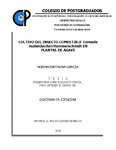| dc.contributor.author | Espinosa García, Norma | |
| dc.creator | ESPINOSA GARCÍA, NORMA; 276663 | |
| dc.date.accessioned | 2020-02-13T14:59:05Z | |
| dc.date.available | 2020-02-13T14:59:05Z | |
| dc.date.issued | 2018-11 | |
| dc.identifier.uri | http://hdl.handle.net/10521/4245 | |
| dc.description | Tesis (Doctorado en Ciencias, especialista en Entomología y Acarología).- Colegio de Postgraduados, 2018. | es_MX |
| dc.description.abstract | El consumo del insecto comestible Comadia redtenbacheri (Hammerschmidt) conocido como “gusano rojo del maguey” aumentó en los últimos años, lo que ha llevado a una colecta excesiva de poblaciones silvestres de esta especie. Por ello, la presente investigación propone métodos para la infestación inducida de plantas de Agave salmiana en macetas con larvas de 0.12 g y mayores a 0.30 g de peso promedio a densidades de 20, 30 y 40 por planta, así como adultos recién emergidos en las proporciones hembra-macho 1:1, 1:2 y 2:1, además de plantas en el suelo con larvas de más de 0.30 g a densidades de 30, 60, 90 y 120. Las larvas de mayor peso en macetas a densidades de 30 y 40 individuos por planta, presentaron más capullos y emergencia de adultos. La proporción hembras-machos 1:2 tuvo un promedio de 12 larvas por planta y 75% de plantas infestadas. Con las larvas liberadas en el suelo a una densidad de 60 por planta, se logró el establecimiento de una segunda generación con 72% de plantas infestadas y 14.5% de daño promedio al interior del tallo. Los resultados obtenidos pueden servir de base para programas de producción o restablecimiento de poblaciones de gusano rojo. El mayor número de perforaciones en el tallo se presentó en la especie Agave salmiana variedad Manso, considerado el hospedero preferente de Comadia redtenbacheri. _______________ Comadia redtenbacheri HAMMERSCHMIDT FARMING IN AGAVE PLANTS. ABSTRACT: The consumption of the edible insect Comadia redtenbacheri (Hammerschmidt), known as “agave red worm”, has increased in recent years, which has caused an excessive collection from wild populations. This research proposes methods to induce their infestation in Agave salmiana plants in pots, with larvae of 0.12 g and greater than 0.30 g of weight, at densities of 20, 30 and 40 larvae per plant, as well as newly emerged adults at 1:1, 1:2, and 2:1 female: male ratios, and agave plants planted in pots with soil and larvae greater than 0.30 g at densities of 30, 60, 90 and 120 larvae per plant. The results indicate that in pots, larvae with the higher weight at 30 and 40 larvae per plant, produced the greatest number of pupae and adult emergence. Adults at 1:2 female-male ratio had an average of 12 larvae per plant and 75% of plants infested. The larvae released on pots with soil at densities of 60 larvae by plant, successfully became established and produced a second generation with 72% of plants internally infested, with an average of 14.5% of plant’s stem damage. The results obtained may serve as the basis for the production or population recovery programs of the agave red worm. The highest number of perforations in the stem occurred in the Agave salmiana (Manso), considered the preferred host of Comadia redtenbacheri. | es_MX |
| dc.description.sponsorship | Consejo Nacional de Ciencia y Tecnología (CONACyT). | es_MX |
| dc.format | pdf | es_MX |
| dc.language.iso | spa | es_MX |
| dc.rights.uri | http://creativecommons.org/licenses/by-nc-nd/4.0 | es_MX |
| dc.subject | Gusano rojo | es_MX |
| dc.subject | Agave | es_MX |
| dc.subject | Infestación | es_MX |
| dc.subject | Apareamiento | es_MX |
| dc.subject | Entomofagia | es_MX |
| dc.subject | Redworm | es_MX |
| dc.subject | Infestation | es_MX |
| dc.subject | Mating | es_MX |
| dc.subject | Entomophagy | es_MX |
| dc.subject | Entomología y Acarología | es_MX |
| dc.subject | Doctorado | es_MX |
| dc.subject.classification | BIOLOGÍA Y QUÍMICA::CIENCIAS DE LA VIDA::BIOLOGÍA DE INSECTOS (ENTOMOLOGÍA)::DESARROLLO DE LOS INSECTOS | es_MX |
| dc.title | Cultivo del insecto comestible Comadia redtenbacheri Hammerschmidt en plantas de agave. | es_MX |
| dc.type | Tesis | es_MX |
| Tesis.contributor.advisor | Llanderal Cázares, María Celina Micaela | |
| Tesis.contributor.advisor | Miranda Perkins, Kalina | |
| Tesis.contributor.advisor | González Hernández, Héctor | |
| Tesis.contributor.advisor | Vargas Hernández, Mateo | |
| Tesis.contributor.advisor | Romero Nápoles, Jesús | |
| Tesis.date.submitted | 2018-11 | |
| Tesis.date.accesioned | 2020 | |
| Tesis.date.available | 2020 | |
| Tesis.format.mimetype | pdf | es_MX |
| Tesis.format.extent | 3,473 KB | es_MX |
| Tesis.subject.nal | Insectos comestibles | es_MX |
| Tesis.subject.nal | Edible insects | es_MX |
| Tesis.subject.nal | Agave salmiana | es_MX |
| Tesis.subject.nal | Cossidae | es_MX |
| Tesis.subject.nal | Infestaciones de insectos | es_MX |
| Tesis.subject.nal | Insect infestations | es_MX |
| Tesis.subject.nal | Entomofagia | es_MX |
| Tesis.subject.nal | Entomophagy | es_MX |
| Tesis.subject.nal | Plantas comestibles para fitófagos | es_MX |
| Tesis.subject.nal | Food plants | es_MX |
| Tesis.subject.nal | Cuautlacingo, Otumba, Estado de México, México | es_MX |
| Tesis.rights | Acceso abierto | es_MX |
| Articulos.subject.classification | Gusanos | es_MX |
| dc.type.conacyt | doctoralThesis | es_MX |
| dc.identificator | 2||24||2413||241302 | es_MX |
| dc.contributor.director | LLANDERAL CÁZARES, MARÍA CELINA MICAELA; 1895 | |
| dc.audience | generalPublic | es_MX |


